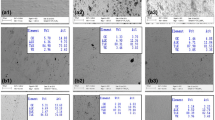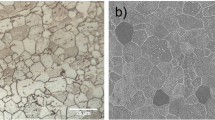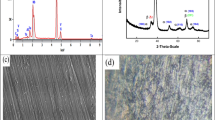Abstract
Cathodic electrical stimulation has previously been studied for both the augmentation of bone healing as well as the treatment of implant associated infections. One of the proposed mechanisms of both of these effects is the electrochemical generation of hydrogen peroxide during the oxygen reduction reaction. Titanium and 316L stainless steel are commonly used as implants and surgical hardware in orthopedic applications. The oxygen reduction reaction has been shown to be complex on passivated metal electrodes such as these. Therefore, the exact potential ranges of H2O2 generation on these materials in physiologically relevant media are not fully characterized. This study employed Rotating Ring-Disk Electrode techniques as well as Scanning Electrochemical Microscopy methods to characterize the electrochemical generation of H2O2 on titanium and 316L stainless steel.
Graphical abstract








Similar content being viewed by others
References
Dymecki SM, Black J, Brighton CT (1984) The cathodic potential dose-response relationship for medullary osteogenesis with stainless steel electrodes. Trans Bioelectr Repair Growth Soc 4:29
Spadaro JA (1982) Electrically enhanced osteogenesis at various metal cathodes. J Biomed Mater Res 16:861–873
Baranowski TJ, Black J (1987) The Mechanism of Faradaic Stimulation of Osteogenesis. In: Blank M, Findle E (eds) Mechanistic approaches to interactions of electrical and electromagnetic fields with living systems. Springer, Boston, pp 399–416
Song C, Zhang J (2008) Electrocatalytic Oxygen Reduction Reaction. Springer, Berlin
Brighton CT, Adler S, Black J, Itada N, Friedenberg ZB (1975) Cathodic oxygen consumption and electrically induced osteogenesis. Clin Orthop Relat Res. https://doi.org/10.1097/00003086-197503000-00033
Brighton CT, Friedenberg ZB (1974) Electrical stimulation and oxygen tension. Ann N Y Acad Sci 238:314–320
Baranowski JTJ. Electrical Stimulation of Osteogenesis by Direct Current: Electrochemically mediated Microenvironmental Alterations [PhD Dissertation]: University of Pennsylvania; 1983.
Bodamyali T, Kanczler JM, Simon B, Blake DR, Stevens CR (1999) Effect of Faradic Products on Direct Current-Stimulated Calvarial Organ Culture Calcium Levels. Biochem Biophys Res Commun 264:657–661
Ehrensberger MT, Tobias ME, Nodzo SR, Hansen LA, Luke-Marshall NR, Cole RF et al (2015) Cathodic voltage-controlled electrical stimulation of titanium implants as treatment for methicillin-resistant Staphylococcus aureus periprosthetic infections. Biomaterials 41:97–105
Nodzo S, Tobias M, Ahn R, Howard C, Hansen L, Luke-Marshall NR et al (2016) Cathodic voltage-controlled electrical stimulation plus prolonged vancomycin reduce bacterial burden of a titanium implant-associated infection in a rodent model. Clin Orthop Relat Res. https://doi.org/10.1007/s11999-016-4705-7
Wang H, Ren D (2017) Controlling Streptococcus mutans and Staphylococcus aureus biofilms with direct current and chlorhexidine. AMB Express 7:204
Istanbullu O, Babauta J, Nguyen HD, Beyenal H (2012) Electrochemical biofilm control: mechanism of action. Biofouling 28:769–778
Jass J, LappinScott HM (1996) The efficacy of antibiotics enhanced by electrical currents against Pseudomonas aeruginosa biofilms. J Antimicrob Chemother 38:987–1000
Del Pozo JL, Rouse MS, Euba G, Greenwood-Quaintance KE, Mandrekar JN, Steckelberg JM et al (2014) Prevention of staphylococcus epidermidis biofilm formation using electrical current. J Appl Biomater Funct Mater 12:81–83
Del Pozo JL, Rouse MS, Euba G, Kang CI, Mandrekar JN, Steckelberg JM et al (2009) The electricidal effect is active in an experimental model of staphylococcus epidermidis chronic foreign body osteomyelitis. Antimicrob Agents Chemother 53:4064–4068
van der Borden AJ, Maathuis PGM, Engels E, Rakhorst G, van der Mei HC, Busscher HJ et al (2007) Prevention of pin tract infection in external stainless steel fixator frames using electric current in a goat model. Biomaterials 28:2122–2126
van der Borden AJ, van der Mei HC, Busscher H (2005) Electric block current induced detachment from surgical stainless steel and decreased viability of Staphylococcus epidermidis. Biomaterials 26:6731–6735
Kalbacova M, Roessler S, Hempel U, Tsaryk R, Peters K, Scharnweber D et al (2007) The effect of electrochemically simulated titanium cathodic corrosion products on ROS production and metabolic activity of osteoblasts and monocytes/macrophages. Biomaterials 28:3263–3272
Le Bozec N, Compere C, L’Her M, Laouenan A, Costa D, Marcus P (2001) Influence of stainless steel surface treatment on the oxygen reduction reaction in seawater. Corros Sci 43:765–786
Alexander CL, Liu C, Alshanoon A, Katona RM, Kelly RG, Carpenter J et al (2018) Oxygen reduction on stainless steel in concentrated chloride media. J Electrochem Soc 165:C869–C877
Bard AJ (1980) Electrochemical methods : fundamentals and applications. Wiley, New York
Paulus UA, Schmidt TJ, Gasteiger HA, Behm RJ (2001) Oxygen reduction on a high-surface area Pt/Vulcan carbon catalyst: a thin-film rotating ring-disk electrode study. J Electroanal Chem 495:134–145
Sanchez-Sanchez CM, Bard AJ (2009) Hydrogen peroxide production in the oxygen reduction reaction at different electrocatalysts as quantified by scanning electrochemical microscopy. Anal Chem 81:8094–8100
Clark CM, Ruszala BM, Ehrensberger MT (2020) Development of durable microelectrodes for the detection hydrogen peroxide and pH. Med Devices Sens. https://doi.org/10.1002/mds3.10074
Lewandowski Z, Beyenal H (2014) Fundamentals of biofilm research, 2nd edn. Taylor & Francis Group, Boca Raton
Dobrzeniecka A, Zeradjanin A, Masa J, Puschhof A, Stroka J, Kulesza PJ et al (2013) Application of SECM in tracing of hydrogen peroxide at multicomponent non-noble electrocatalyst films for the oxygen reduction reaction. Catal Today 202:55–62
Jensen MB, Tallman DE (2013) A LabVIEW-based virtual instrument for simulation and analysis of SECM approach curves. J Solid State Electrochem 17:2999–3003
Stewart PS, Roe F, Rayner J, Elkins JG, Lewandowski Z, Ochsner UA et al (2000) Effect of catalase on hydrogen peroxide penetration into Pseudomonas aeruginosa biofilms. Appl Environ Microbiol 66:836–838
Mentus S (2004) Oxygen reduction on anodically formed titanium dioxide. Electrochemica Acta 50:27–32
Vetter KJ (1967) Electrochemical Kinetics: theoretical and experimental Aspects. Academic Press, New York
Contu F (2012) The Cathodic behavior of titanium: serum effect. J Biomed Mater Res 100B:544–552
Park J, Du P, Jeon JK, Jang GH, Hwang MP, Han HS et al (2015) Magnesium corrosion triggered spontaneous generation of H2O2 on oxidized titanium for promoting angiogenesis. Angew Chem-IntEdit 54:14753–14757
Acknowledgements
CMC would like to acknowledge the support of the STEM Student Employment Program (SSEP) at the U.S. Naval Research Laboratory.
Author information
Authors and Affiliations
Corresponding author
Ethics declarations
Conflict of interest
There are no conflicts of interest to declare.
Additional information
Publisher's Note
Springer Nature remains neutral with regard to jurisdictional claims in published maps and institutional affiliations.
Rights and permissions
About this article
Cite this article
Clark, C.M., Ruszala, B.M., Anderson, R.M. et al. Electrochemical generation of hydrogen peroxide during cathodic polarization of metallic orthopedic biomaterials. J Appl Electrochem 53, 1147–1156 (2023). https://doi.org/10.1007/s10800-022-01840-5
Received:
Accepted:
Published:
Issue Date:
DOI: https://doi.org/10.1007/s10800-022-01840-5




